- Make the Most of Your Visit to Himeji Castle—Down to the Last Stone
- Sakuramon Bridge
- Otemon (Sakuramon) Gate
- World Heritage Himeji Castle Monument
- Site of the Mukai-Oyashiki Residence
- Site of the San-no-Maru
- Site of the Former Three-Story Turret (Sanjū Yagura Ato)
- Site of the Musashino Palace
- Site of the Sagiyamaguchi Gate
- Roan Teahouse
- Onnazaka (Women’s Slope)
- Hishi-no-Mon Gate
- Himeji Castle Map
- Related Articles on Himeji Castle
- 🔙 Return to the Warload Page
Make the Most of Your Visit to Himeji Castle—Down to the Last Stone
In Area 1, you’ll explore 11 key locations that set the stage for your Himeji Castle experience. From the World Heritage Monument and remains of historic residences and gates to peaceful spots like the Roan Teahouse and the gentle slope of Onnazaka, this area offers a rich introduction to the castle’s layered history.
Highlights include the Site of the San-no-Maru, where retainers once assembled; the Former Three-Story Turret Site, which hints at past grandeur; and the impressive Hishi-no-Mon Gate, the powerful first gate of the inner compound. Each site reveals a different facet of the castle’s evolution from its early days to its Edo-period magnificence.
Sakuramon Bridge
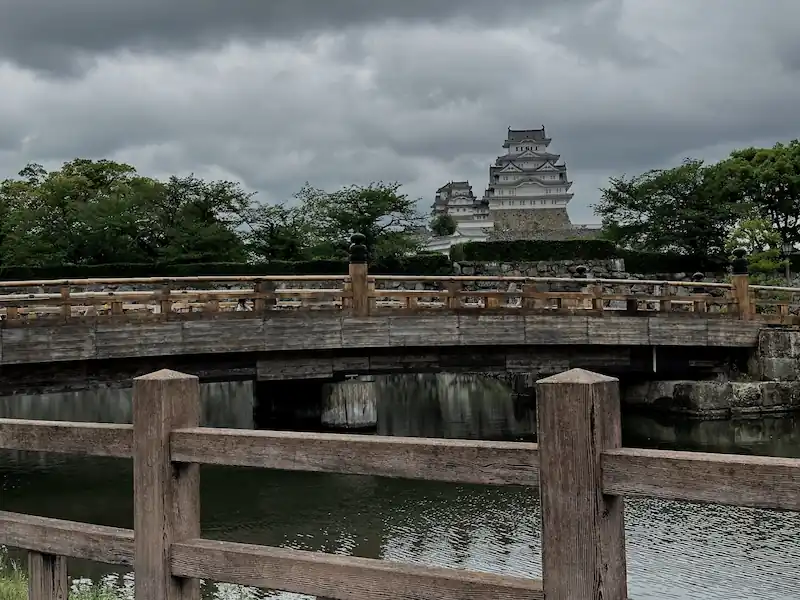
⭐ Recommended Rating
Historical Significance: ☆☆
Visual Appeal: ☆☆☆
Experiential Value: ☆☆
🏛 Overview
Often considered the main gateway to Himeji Castle, Sakuramon Bridge marks the symbolic starting point for any visit to this historic landmark. As you approach from Himeji Station, the castle’s radiant white main keep appears through the trees, with this iconic bridge coming into view just ahead.
Spanning the castle’s inner moat, Sakuramon Bridge stands in alignment with the imposing Otemon Gate, guiding visitors into the grandeur of the castle grounds. The current bridge, reconstructed in 2007 using Edo-period maps and records, reflects the traditional design used during that era, its location and function remain unchanged since the Edo period. Local legends suggest that Toyotomi Hideyoshi may have passed through this area during his time as lord of Himeji Castle.
When Hideyoshi transformed Himeji Castle into a modern fortress in 1580, this area was strategically important for both defense and ceremonial functions. With the White Heron Castle as its stunning backdrop, Sakuramon Bridge has become a popular photo spot, especially beloved for its picturesque views.
| Item | Content |
|---|---|
| Year Built | Unknown (originally existed during the Edo period) |
| Builder | Unknown |
| Structure/Features | A wooden pedestrian bridge crossing the outer moat. Traditional design from the Edo period. Famous for cherry blossoms. |
| Renovation/Restoration | The original bridge was removed in the Meiji era. Rebuilt in 2007 using old maps and records. |
| Current Status | Present-day version is standing |
| Destruction/Damage | The original bridge was dismantled during the Meiji period |
| Cultural Property Designation | Unknown |
| Remarks | Located at the main entrance of Himeji Castle. Very popular for photos during cherry blossom season. |
🗺 Address:
68 Honmachi, Himeji City, Hyogo Prefecture
🚶 Access
Nearest station: Approx. 15-minute walk (1.2 km) from JR Himeji Station
⏳ Suggested Visit Duration
Quick stop: Around 5 minutes
In-depth visit: Around 15 minutes
📍 Highlights
🔹 View of the Main Keep from the Bridge: The sight of Himeji Castle towering above as you stand on Sakuramon Bridge is truly breathtaking. It leaves a lasting first impression.
🔹 Harmonious Architecture with Otemon Gate: The wooden bridge, paired with robust stone walls and the impressive Otemon Gate, evokes the aesthetic of a Sengoku-period stronghold.
🔹 Seasonal Beauty: In spring, cherry blossoms bloom in abundance around the bridge, creating a scene worthy of the name “Sakuramon.” The area bustles with hanami crowds, and evening illuminations offer a dreamlike atmosphere.
📌 Trivia
Unexpected History: The current bridge was rebuilt during the Showa era, but historical records show that during the Edo period it was sometimes dismantled and reconstructed as part of the castle’s defensive mechanisms.
Hidden Details: The railings of Sakuramon Bridge feature the family crest of Himeji City—a subtle touch that castle enthusiasts love to spot.
Famous Connections: Toyotomi Hideyoshi, during his days as Hashiba Hideyoshi, ruled the Harima region and became the lord of Himeji Castle. This bridge is said to have been the path of his departure, marking the start of his rise to power.
Otemon (Sakuramon) Gate
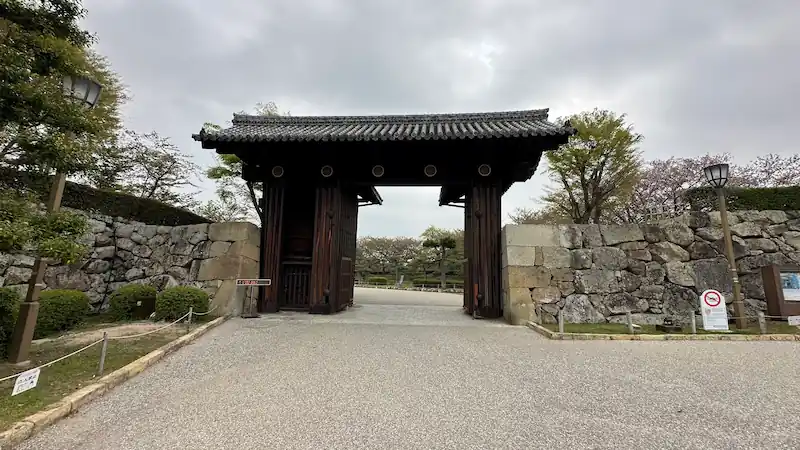
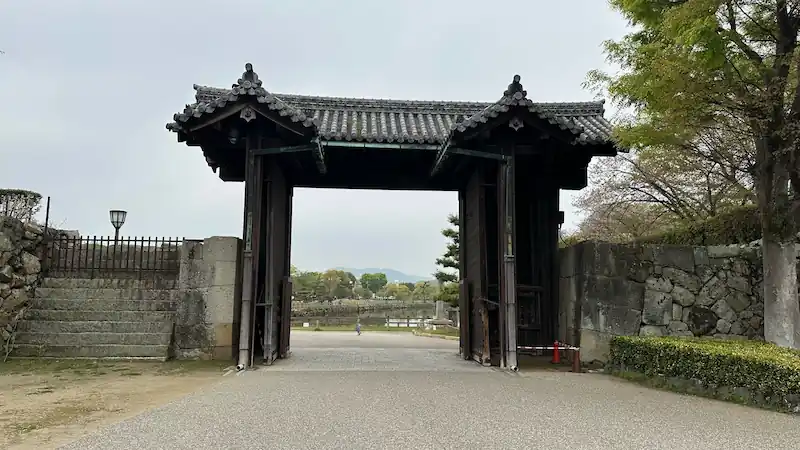
⭐ Recommended Rating
Historical Significance: ☆
Visual Appeal: ☆☆☆
Experiential Value: ☆☆
🏛 Overview
As you step into the grounds of Himeji Castle, the first structure to greet you is the grand Otemon Gate—also known as Sakuramon. Surrounded by towering stone walls, this gate stands as a powerful symbol of the castle’s history and prestige.
Originally built during the transition from the Sengoku to the Edo period, Otemon showcases the architectural brilliance of a true defensive structure. The current gate is recognized as one of the “Third Otemon Gates” established during the Edo era and remains a proud sentinel welcoming all visitors to Himeji Castle.
Toyotomi Hideyoshi captured the Harima region in 1577 and began major renovations to Himeji Castle in 1580. This gate route was a key part of his reconstruction plan, which introduced stone wall techniques and laid the foundation for the modern Japanese castle. Today, the gate has been faithfully rebuilt in wood, and its solid construction and flanking high stone walls offer an immersive step back into the age of samurai.
| Item | Content |
|---|---|
| Year Built | Unknown (existed before or during the Edo period) |
| Builder | Unknown |
| Structure/Features | A masugata-style wooden gate. Served as the castle’s main entrance, located just past Sakuramon Bridge. Important for defense and appearance. |
| Renovation/Restoration | Removed in the Meiji era and rebuilt in 1937 in the style of a Koraimon gate. |
| Current Status | Still standing (reconstructed in 1937) |
| Destruction/Damage | Dismantled during the Meiji period when the castle was used as a military base. |
| Cultural Property Designation | Unknown |
| Remarks | This gate is the main entrance to Himeji Castle, welcoming visitors from the third bailey area after crossing Sakuramon Bridge. |
🗺 Address:
68 Honmachi, Himeji City, Hyogo Prefecture
🚶 Access
Approx. 1-minute walk (40 meters) from Sakuramon Bridge
⏳ Suggested Visit Duration
Quick stop: Around 5 minutes
In-depth visit: Around 15 minutes
📍 Highlights
🔹 Defensive Design of the Gate: More than just an entrance, Otemon is a strategic defensive structure. The thick gates and flanking stone walls speak volumes about its military purpose.
🔹 Harmony with Otemae Square: In front of the gate lies the vast Otemae Square, which enhances the grandeur of the castle. During events, the square becomes lively and festive.
🔹 Seasonal Beauty: In spring, cherry blossoms form a natural archway around the gate, creating a scene that lives up to the name “Sakuramon.” In autumn, the foliage adds a colorful touch, attracting photographers and visitors alike.
📌 Trivia
Surprising History: The gate has undergone name and design changes over the centuries. The moniker “Sakuramon” is believed to have originated from the magnificent cherry trees planted nearby.
Lesser-Known Fact: Look closely at the stone walls on either side of the gate to spot “carvings” left by Edo-period stonemasons—these engravings identify individual workers or regional clans.
Famous Connections: During the Showa era, members of the Japanese Imperial family passed through this gate when visiting Himeji Castle, giving it the nickname “Gateway of Honor.”
World Heritage Himeji Castle Monument
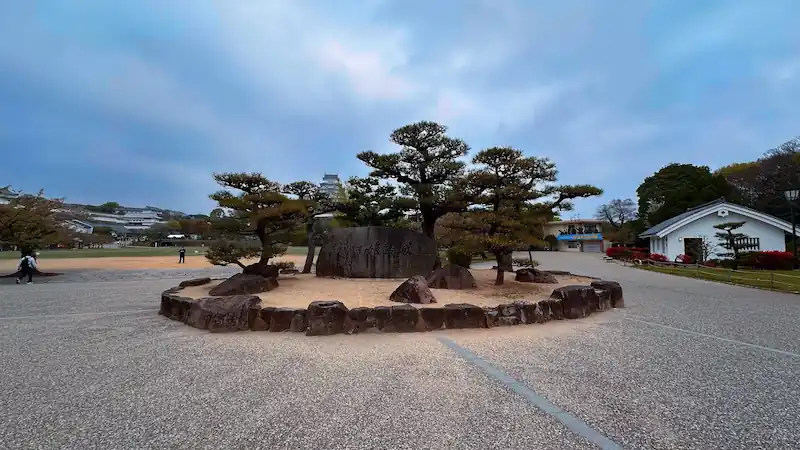
⭐ Recommended Rating
Historical Significance: ☆
Visual Appeal: ☆☆
Experiential Value: ☆
🏛 Overview
The World Heritage Himeji Castle Monument commemorates Himeji Castle’s designation as One of the first UNESCO World Cultural Heritage sites in Japan, registered in 1993. Located just beyond the inner moat in San-no-Maru Square, it offers a prime view of the castle’s striking white keep.
This monument conveys the deep historical and cultural value of the castle, highlighting why it is more than just a beautiful structure—it is a globally significant heritage site.
The inscription on the monument explains why Himeji Castle was recognized by UNESCO. Known as the “White Heron Castle” for its graceful appearance, the fortress exemplifies Japan’s early modern castle architecture. Originally shaped by Toyotomi Hideyoshi and expanded by Ikeda Terumasa during the Edo period, the castle remains remarkably intact. Its architectural perfection, preservation, and fusion of feudal government and culture earned it this prestigious title.
Standing before this monument, one can truly appreciate Himeji Castle as a “living cultural treasure” admired around the world.
| Item | Content |
|---|---|
| Year Built | 1993 (Heisei 5) |
| Builder | Unknown |
| Structure/Features | A stone monument. Put up to mark the year Himeji Castle was listed as a World Heritage site. |
| Renovation/Restoration | Unknown |
| Current Status | Still there |
| Destruction/Damage | Unknown |
| Cultural Property Designation | Unknown |
| Remarks | This monument helps remind visitors of the castle’s global cultural value. It stands near the entrance area. |
🗺 Address:
68 Honmachi, Himeji City, Hyogo Prefecture (Near San-no-Maru Square within Himeji Castle grounds)
🚶 Access
Approx. 1-minute walk (87 meters) from Otemon (Sakuramon) Gate
⏳ Suggested Visit Duration
Quick stop: Around 5 minutes
In-depth visit: Around 10–15 minutes (including reading the inscription and taking photos)
📍 Highlights
🔹 UNESCO Plaque Inscription: The text clearly outlines the global significance of Himeji Castle, helping visitors understand its heritage value.
🔹 Contrast with the Main Keep: The monument’s location offers a picture-perfect contrast with the brilliant white castle behind it—ideal for photography.
🔹 Seasonal Beauty: In spring, cherry blossoms envelop the monument in color. In autumn, vivid foliage surrounds it, creating a picturesque historical scene.
📌 Trivia
Unexpected History: Himeji Castle and Horyu-ji Temple were the first sites in Japan to receive UNESCO World Cultural Heritage status, making this monument a symbol of that milestone.
Lesser-Known Fact: The monument’s position was meticulously selected to offer the most photogenic view—so much so that even professional photographers use it as a shooting spot.
Famous Connections: At the time of registration, cultural agency officials and UNESCO delegates visited this exact location, marking a proud moment in Japan’s heritage conservation history.
Site of the Mukai-Oyashiki Residence
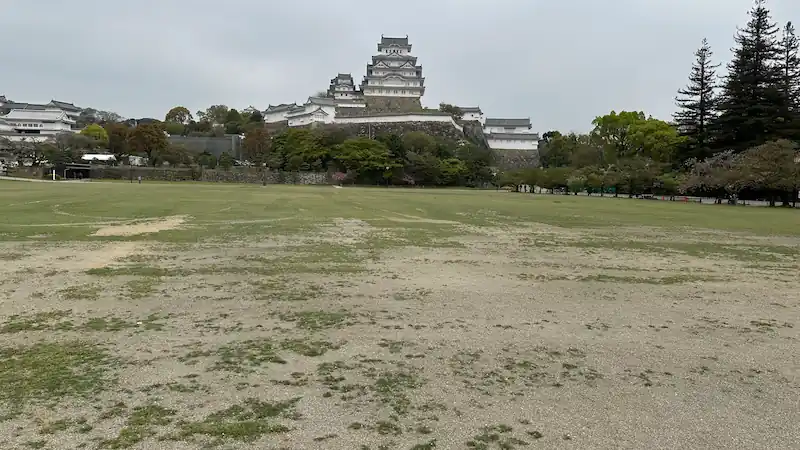
⭐ Recommended Rating
Historical Significance: ☆☆
Visual Appeal: ☆
Experiential Value: ☆
🏛 Overview
The Site of the Mukai-Oyashiki Residence lies to the north of Himeji Castle’s Ni-no-Maru area and once housed family members and senior retainers of the domain’s lord. The term Mukai means “opposite” or “facing,” referencing the site’s position across from the castle’s main citadel.
Believed to be home to close advisors, administrators, and family members, this residence area illustrates Himeji Castle’s dual nature—not only as a military stronghold, but also as a center of governance and everyday life. Although the original structures are gone, the wide plot, stone walls, and uneven terrain suggest the scale and organization of this residential complex.
This area was not developed during Hideyoshi’s era, but was later expanded by Ikeda Terumasa as part of the castle’s transition into a seat of administration during the early Edo period. In this sense, the Mukai-Oyashiki Site embodies the transformation of Himeji Castle from Hideyoshi’s “strategic fortress” into Ikeda’s “political capital.”
| Item | Content |
|---|---|
| Year Built | Unknown (likely during the Edo period) |
| Builder | Unknown |
| Structure/Features | Traditional Japanese residence, possibly with thatched roof and wooden construction, typical of samurai homes of the time. |
| Renovation/Restoration | Unknown |
| Current Status | Only the site remains; original structures no longer exist. |
| Destruction/Damage | Original buildings were likely lost during the Meiji period or later urban development. |
| Cultural Property Designation | Unknown |
| Remarks | The site is near Himeji Castle and is believed to have been the location of a samurai residence during the Edo period. |
🗺 Address:
68 Honmachi, Himeji City, Hyogo Prefecture
🚶 Access
Approx. 1-minute walk (80 m) from World Heritage Himeji Castle Monument
⏳ Suggested Visit Duration
Quick stop: 10 minutes
In-depth visit: Around 20 minutes (to explore stonework and terrain)
📍 Highlights
🔹 Layout of the Residence: Though no buildings remain, the leveled grounds and perimeter stone walls indicate the layout and scale of the former residence.
🔹 Harmony with Nature: Surrounded by lawns and trees, the site offers a tranquil retreat and is ideal for leisurely walks.
🔹 Seasonal Beauty: In spring, budding trees soften the landscape; in autumn, vivid foliage paints a calming, nostalgic picture.
📌 Trivia
Unexpected History: This area likely housed the female attendants and household staff of the ruling family, serving as the behind-the-scenes heart of the castle.
Lesser-Known Fact: Faint traces of layout markers remain in the terrain, making this spot a favorite for archaeology enthusiasts.
Famous Connections: Records from the Bakumatsu period suggest that relatives of the Sakai lords resided here and may have discussed political developments on the eve of the Meiji Restoration.
Site of the San-no-Maru

⭐ Recommended Rating
Historical Significance: ☆☆
Visual Appeal: ☆
Experiential Value: ☆
🏛 Overview
The Site of the San-no-Maru is a vast open area just beyond Himeji Castle’s main entrance, Otemon Gate. Once the administrative and residential heart of the domain during the Edo period, it housed government offices, the lord’s residence, and samurai officials’ quarters. While the original structures are now gone, the expansive lawn and stone walls remain, offering one of the best panoramic views of the castle’s majestic main keep. It’s a favorite gathering spot for visitors and a prime location for photos, events, and peaceful strolls.
San-no-Maru functioned as the castle’s hub for governance and daily life, in contrast to the military-centric Honmaru and Ni-no-Maru. It likely included a formal residence area for high-ranking retainers or family members of the domain lord, though the original names of these buildings have not been preserved. During Hideyoshi’s era, only a modest cluster of buildings existed here, but under Ikeda Terumasa, San-no-Maru was developed into a large and formal complex built upon the foundations Hideyoshi had laid for a modern castle.
Today, the area serves as a versatile space used for events, photography, and leisure. With seasonal changes in the landscape, it remains a place where visitors can feel the pulse of history.
| Item | Content |
|---|---|
| Year Built | Early 17th century (Edo period) |
| Builder | Honda family, lords of Himeji from 1617 to 1639 |
| Structure/Features | Administrative center with palatial buildings, tea houses, gardens, and ponds; a 21-meter-wide avenue led toward the main keep |
| Renovation/Restoration | All buildings removed during the Meiji era; currently, only rows of gray flagstones mark the edges of the old central avenue and foundations |
| Current Status | Open plaza with lawn and cherry trees; serves as a popular viewing spot for tourists |
| Destruction/Damage | Structures dismantled during the Meiji period when the area was repurposed for military use |
| Cultural Property Designation | Unknown |
| Remarks | Located just inside the Otemon Gate; offers direct views of the castle keep and is especially popular during cherry blossom season |
🗺 Address:
68 Honmachi, Himeji City, Hyogo Prefecture (San-no-Maru Square)
🚶 Access
Approx. 0-minute walk (0 m) from Site of the Mukai-Oyashiki Residence
⏳ Suggested Visit Duration
Quick stop: 10 minutes
In-depth visit: 30 minutes (for walking the grounds, reading signage, and taking photos)
📍 Highlights
🔹 Stunning Castle Viewpoint: San-no-Maru offers an unobstructed view of the entire castle keep—one of the few places where you can see it in full. It’s frequently featured in tourism posters.
🔹 Restored Stone Layout Lines: Embedded stone lines mark the footprints of former buildings and divisions, allowing visitors to visualize the historical layout.
🔹 Seasonal Beauty: In spring, blooming cherry blossoms welcome visitors. In autumn, golden grass and fiery red leaves create a magical visual contrast.
📌 Trivia
Unexpected History: San-no-Maru is thought to have functioned as an administrative center of the Himeji Domain, possibly hosting finance and legal offices, though specific building uses remain uncertain. It truly was the “brain” of the castle.
Lesser-Known Fact: Beneath today’s plaza lie untouched Edo-period remains. Future archaeological excavations may uncover new insights.
Famous Connections: In the final years of the Edo period, statesman Katsu Kaishu reportedly met with samurai here—making it a stage for historical turning points.
Site of the Former Three-Story Turret (Sanjū Yagura Ato)
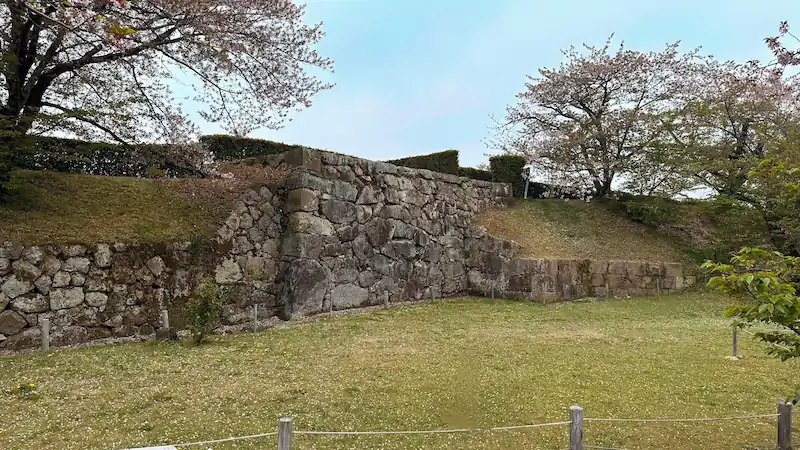
⭐ Recommended Rating
Historical Significance: ☆☆
Visual Appeal: ☆☆
Experiential Value: ☆
🏛 Overview
The Site of the Former Three-Story Turret marks where a vital three-story watchtower once stood, guarding the main entrance to Himeji Castle. While the structure itself no longer remains, the stone base and land contours offer a vivid reminder of its once-formidable presence.
These ruins stir the imagination, transporting visitors back to a time when architecture and strategy were intricately entwined in castle defense.
Believed to have been constructed during Hideyoshi’s 1580 renovation of Himeji Castle, the turret occupied a critical position in the fortress’s defense system. Located directly in front of Otemon Gate, it served as the first line of resistance against invaders—an ideal post for monitoring activity and repelling enemies with arrows or gunfire.
Even as the castle evolved during the Edo period, this site retained its strategic importance. The stone walls display techniques like Nozura-zumi and Uchikomi Hagi, offering valuable insights into construction practices and innovations of the era.
Though the structure has vanished, its role and significance endure. The Former Three-Story Turret site is a testament to the intelligence and craftsmanship of Japan’s feudal fortification design—a silent yet eloquent storyteller from the past.
| Item | Content |
|---|---|
| Year Built | 1581 (Tenshō 9) |
| Builder | Toyotomi Hideyoshi |
| Structure/Features | A three-story turret believed by some to have served as the main keep during Hideyoshi’s time at Himeji Castle, surrounded by stone walls. |
| Renovation/Restoration | Demolished in 1601 when Ikeda Terumasa began major renovations to expand the castle complex. |
| Current Status | No longer exists; only the site remains. |
| Destruction/Damage | Removed during early 17th-century reconstruction efforts. |
| Cultural Property Designation | Unknown |
| Remarks | This turret was part of Hideyoshi’s original design and was replaced by the current main keep built by Ikeda Terumasa. |
🗺 Address:
68 Honmachi, Himeji City, Hyogo Prefecture (Inside Himeji Castle)
🚶 Access
Approx. 2-minute walk (120meters) from Site of the San-no-Maru
⏳ Suggested Visit Duration
Quick stop: Around 5 minutes
In-depth visit: Around 15 minutes (including observing the stonework and surrounding terrain)
📍 Highlights
🔹 Foundation Stonework: The sturdy stone base of the turret remains intact, showcasing the high level of castle construction skill.
🔹 Panoramic View of Otemon Gate: From this vantage point, you can see directly toward Otemon, highlighting the site’s strategic positioning.
🔹 Seasonal Beauty: In spring, wildflowers bloom around the stonework, blending nature with historical remnants. In autumn, fallen leaves create a striking contrast with the stones.
📌 Trivia
Unexpected History: The turret is believed to have been destroyed by fire during the late Sengoku to early Edo period. No efforts to rebuild it are evident, making it a “phantom structure.”
Lesser-Known Fact: The site features a blend of stone-laying techniques, allowing visitors to compare different construction styles from various eras.
Famous Connections: Some theories suggest that Kuroda Kanbei, a strategist close to Hideyoshi, may have influenced the castle’s early defensive layout, though this remains speculative.
Site of the Musashino Palace
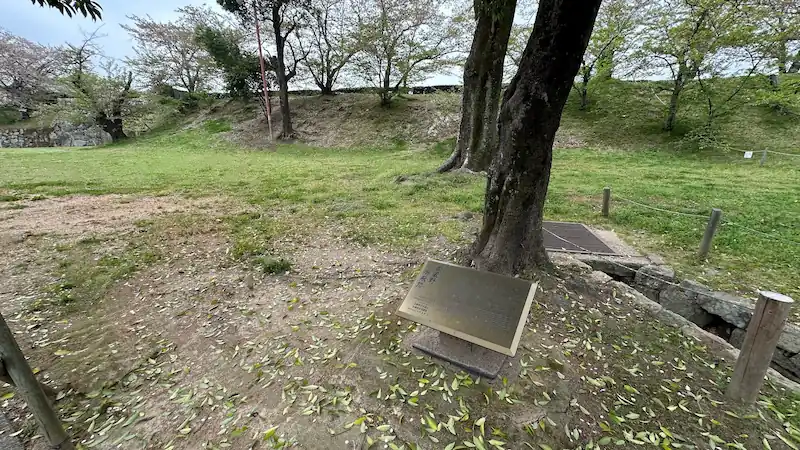

⭐ Recommended Rating
Historical Significance: ☆☆
Visual Appeal: ☆
Experiential Value: ☆
🏛 Overview
This area, sometimes referred to in modern guides as the Site of the Musashino Palace, though the original name of the residence has not been confirmed in historical records is located in the important San-no-Maru area of Himeji Castle, where a once-elegant residence for the feudal lord stood. Though today only foundational stones and remnants of a garden remain, this site once functioned as the castle’s “guest palace”—a place where the lord of Himeji conducted official affairs and received important guests. Unlike the battlefield persona often associated with Himeji Castle, this area conveys the more refined and peaceful side of governance and everyday life.
The name Musashino refers to a symbolic region in the Kanto area, where the Tokugawa shogunate was based—highlighting Himeji Domain’s strong ties with the central government. Developed under Ikeda Terumasa from 1601 onward, the palace served as a grand venue to entertain visiting daimyo and shogunal envoys during official processions.
Judging by the scale and layout of the palace and gardens, it likely showcased intricate design and sophisticated construction techniques. Although the buildings are gone, the arranged plot, scattered foundation stones, and traces of the landscape still evoke the elegance of a bygone era. The palace did not exist during Hideyoshi’s time but was built atop the castle foundations he had laid, becoming a political and residential core during the early Edo period.
From a military fortress to a seat of political and cultural sophistication—the Musashino Palace site represents another face of Himeji Castle. It offers a serene environment where visitors can reflect on this rich, refined history.
| Item | Content |
|---|---|
| Year Built | Early 17th century (Edo period) |
| Builder | Honda Tadatoki |
| Structure/Features | A residence within the Third Bailey (San-no-Maru) of Himeji Castle, known for its elegant sliding doors decorated with gold leaf and pampas grass designs, reminiscent of the Musashino plains. |
| Renovation/Restoration | Unknown |
| Current Status | No longer exists; only the site remains. |
| Destruction/Damage | Likely dismantled during the Meiji period when many castle structures were removed. |
| Cultural Property Designation | Unknown |
| Remarks | Built as the residence for Princess Sen and her husband, Honda Tadatoki. The term ‘Musashino Palace’ is thought to have been inspired by the aesthetic of the Musashino plains, though the original name of the residence remains unclear. |
🗺 Address:
68 Honmachi, Himeji City, Hyogo Prefecture
🚶 Access
Approx. 1-minute walk (110 m) from Site of the Former Three-Story Turret (Sanjū Yagura Ato)
⏳ Suggested Visit Duration
Quick stop: 5 minutes
In-depth visit: 15 minutes (to explore the site and surrounding layout in detail)
📍 Highlights
🔹 Foundation Stones and Ruins: Scattered foundation stones reveal the scale and layout of the former residence, inviting visitors to envision the grandeur of the past.
🔹 Garden Remnants: Fragmented landscaping and natural contours hint at the original garden, offering a quiet and reflective space perfect for strolling.
🔹 Seasonal Beauty: In spring, budding greenery adds a touch of new life to the site, while in autumn, the contrast of fallen leaves and moss-covered stones creates a peaceful, picturesque scene.
📌 Trivia
Unexpected History: The palace once served as an administrative and ceremonial venue, offering rare insight into the castle’s everyday life beyond its military function.
Lesser-Known Fact: Some speculate that ancient stone materials from earlier periods, possibly even from the Kofun era, were reused here—but this theory remains unproven—adding another layer to the site’s long historical narrative.
Famous Connections: During the late Edo period, the palace was used to host visiting officials, including envoys of the shogunate and other daimyo.
Site of the Sagiyamaguchi Gate
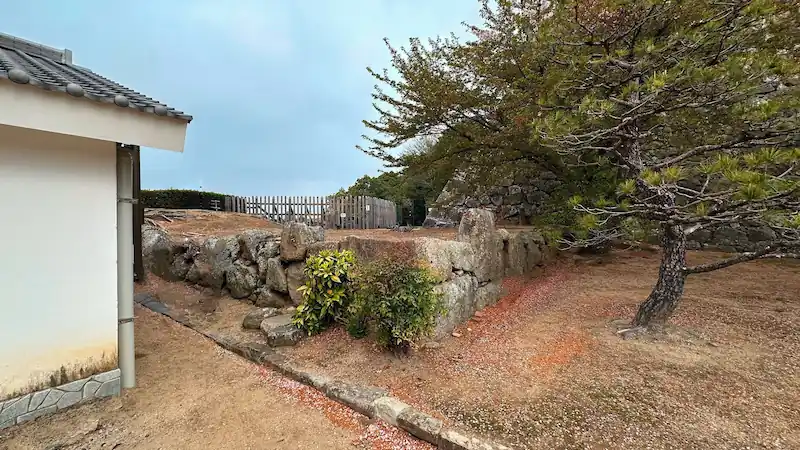
⭐ Recommended Rating
Historical Significance: ☆☆
Visual Appeal: ☆
Experiential Value: ☆
🏛 Overview
The Sagiyamaguchi Gate Site marks the former northern entrance of Himeji Castle. Though now a quiet historical ruin, it once served as a practical access point for castle staff, artisans, and occasionally troops. As a rear gate, it played a key logistical role rather than a ceremonial or defensive one.
Named after Mount Sagi—considered the origin of Himeji Castle’s poetic nickname Shirasagi-jo or “White Heron Castle”—this gate has deep ties to the castle’s identity. While the gate itself no longer exists, remnants of the stone walls and the distinct shape of the gateway remain, revealing insights into the strategic planning of entry points during castle construction.
During Hideyoshi’s modernization of the castle in 1580, the northern area was also fortified, offering a glimpse into the evolution from mountain fortresses to early modern castles. This site, though understated, presents a fascinating perspective on Himeji’s architectural and strategic history.
| Item | Content |
|---|---|
| Year Built | Unknown (likely during the early Edo period) |
| Builder | Unknown |
| Structure/Features | Served as a rear entrance to Himeji Castle, possibly a simple wooden gate with defensive features. |
| Renovation/Restoration | Unknown |
| Current Status | No longer exists; only the site remains. |
| Destruction/Damage | Likely dismantled during the Meiji period when many castle structures were removed. |
| Cultural Property Designation | Unknown |
| Remarks | Located on the western side of the castle grounds; the exact location and details are not well-documented. |
🗺 Address:
68 Honmachi, Himeji City, Hyogo Prefecture
🚶 Access
Approx. 3-minute walk (260 m) from Site of the Musashino Palace
⏳ Suggested Visit Duration
Quick stop: 5 minutes
In-depth visit: 15 minutes (for observing the ruins and taking photos)
📍 Highlights
🔹 Stone Walls and Gateway Layout: Though the gate itself is gone, Some terrain features suggest it may have had a masugata-style layout—a defensive box-shaped configuration common in Edo-period castles.
🔹 Tranquil Atmosphere: Unlike the crowded main entrances, this northern area remains calm and serene, offering a more introspective historical experience.
🔹 Seasonal Beauty: In early summer, sunlight filters through the lush green foliage onto the stone walls. In autumn, colorful leaves blanket the path.
📌 Trivia
Unexpected History: Some theories suggest the Sagiyamaguchi Gate was also designed as an emergency escape route—underscoring its role as more than just a security feature.
Lesser-Known Fact: Nearby remnants include an old well and earthen mounds, making it a hidden gem for fans of historical terrain analysis.
Famous Connections: In the Meiji period, this area was used as a military training ground, with army officers reportedly using this path for their exercises.
Roan Teahouse
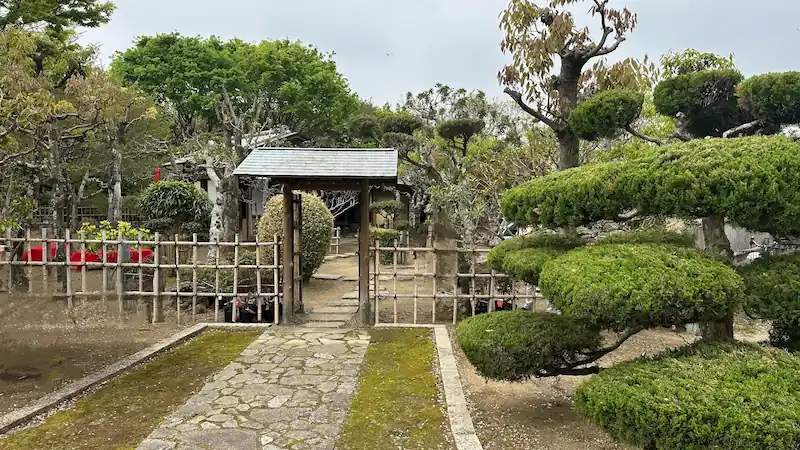

⭐ Recommended Rating
Historical Significance: ☆☆
Visual Appeal: ☆☆
Experiential Value: ☆☆
🏛 Overview
Nestled quietly on the northern edge of San-no-Maru Square, the Roan Teahouse is a refined sukiya-style structure set against the backdrop of Himeji Castle’s majestic walls and towers. Named after the castle’s alternate title, White Heron Castle, Roan is a sanctuary of tranquility where visitors can savor moments of calm and traditional Japanese hospitality.
Though a recent addition, the teahouse is crafted in strict adherence to classic tea ceremony architecture, offering harmony with nature and history alike.
While Himeji Castle symbolizes military strength and strategic design, Roan reflects omotenashi—the cultural spirit of hospitality—and the aesthetics of Japanese tea tradition. Like many powerful daimyo of the era, Hideyoshi himself was an avid practitioner of the tea ceremony and is known to have hosted tea gatherings within the castle. Roan brings that cultural legacy into the modern age.
Constructed from wood and natural materials, the teahouse is harmoniously integrated with its surrounding garden, stepping stones, and roji (tea garden path). Entering the interior, guests are immersed in the serene world of wabi-sabi, where each season offers a different mood and texture. Roan provides a moment to recalibrate after exploring the grandeur of Himeji Castle—a place where time seems to slow.
| Item | Content |
|---|---|
| Year Built | Unknown |
| Builder | Unknown |
| Structure/Features | A traditional Japanese teahouse, likely constructed in the sukiya-zukuri architectural style, reflecting the aesthetics of the Edo period. |
| Renovation/Restoration | Unknown |
| Current Status | Still standing |
| Destruction/Damage | Unknown |
| Cultural Property Designation | Unknown |
| Remarks | Located within the grounds of Himeji Castle, the Roan Teahouse offers visitors a serene setting to experience traditional Japanese tea culture. |
🗺 Address:
68 Honmachi, Himeji City, Hyogo Prefecture
🚶 Access
Approx. 1-minute walk (50 m) from Site of the Sagiyamaguchi Gate
⏳ Suggested Visit Duration
Quick stop: 10 minutes (for viewing and strolling the garden)
In-depth visit: 30 minutes (including matcha service)
📍 Highlights
🔹 Sukiya-style Architecture: Crafted from wood and natural materials, the teahouse exudes quiet beauty and refined simplicity.
🔹 Tea Service (Paid): Enjoy matcha and traditional sweets in a serene setting—a luxurious pause in your journey.
🔹 Seasonal Beauty: Cherry blossoms bloom in spring, cool greenery offers shade in summer, brilliant autumn leaves follow, and in winter, the hearth brings warmth to the silence.
📌 Trivia
Unexpected History: While there are no historical records tying this exact site to Hideyoshi’s tea ceremonies, Roan Teahouse serves as a modern tribute to that cultural legacy. Roan is seen as a modern tribute to those historic moments.
Lesser-Known Fact: Behind the teahouse lies a charming arrangement of tsukubai and tobi-ishi, allowing visitors to appreciate a complete roji garden experience.
Famous Connections: International tea masters and cultural figures have held ceremonies here, and Roan is occasionally highlighted in international travel features as a symbol of traditional Japanese aesthetics within Himeji Castle.”
Onnazaka (Women’s Slope)
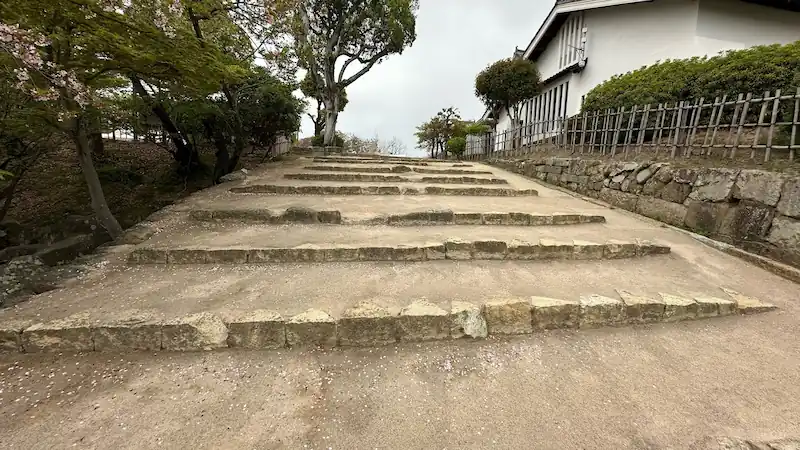
⭐ Recommended Rating
Historical Significance: ☆☆
Visual Appeal: ☆
Experiential Value: ☆
🏛 Overview
Onnazaka, or “Women’s Slope,” is a gently sloping stone stairway that connects San-no-Maru Square to Ni-no-Maru within Himeji Castle. Named in contrast to the steep Otokozaka (“Men’s Slope”), this path was not exclusive to women, but its soft curves and easier incline inspired the elegant moniker.
Today, Onnazaka serves as a peaceful passage through the castle grounds, ideal for appreciating the castle’s structure, stonework, and surrounding nature. Legend holds that lords’ wives and noblewomen may have used this very path. Its tranquil air and graceful curve reflect the castle’s more refined side.
During Hideyoshi’s time, the castle was still being fortified, and routes like Onnazaka were as important for daily life as they were for military movement. This path reminds us that Himeji Castle was not just a place of war, but also of domestic life and quiet beauty.
| Item | Content |
|---|---|
| Year Built | Unknown (likely during the Edo period) |
| Builder | Unknown |
| Structure/Features | A gentle sloping path within the castle grounds, traditionally used by women to access the inner areas of the castle. |
| Renovation/Restoration | Unknown |
| Current Status | Still exists and is accessible to visitors. |
| Destruction/Damage | None |
| Cultural Property Designation | Unknown |
| Remarks | Onnazaka offers a scenic route with views of the castle tower, especially beautiful during cherry blossom season. |
🗺 Address:
68 Honmachi, Himeji City, Hyogo Prefecture (San-no-Maru to Ni-no-Maru area)
🚶 Access
Approx. 1-minute walk (110 m) from Roan Teahouse
⏳ Suggested Visit Duration
Quick stop: 5 minutes (while passing through)
In-depth visit: Around 15 minutes (for observing stonework and foliage)
📍 Highlights
🔹 Gentle Curves and Stone Steps: The path’s winding design gives it the look and feel of an old mountain trail—perfect for photos.
🔹 Mossy Stone Walls and Nature: Lush greenery and moss accent the stonework, especially vivid after rain.
🔹 Seasonal Beauty: In spring, wild cherry trees bloom; in autumn, crimson leaves create a picturesque tunnel of color.
📌 Trivia
Unexpected History: During wartime, the slope may have served as an escape route for women, children, and elder retainers—a “path of safety.”
Lesser-Known Fact: Halfway up the slope, you can spot old stonemasons’ marks, revealing the craftsmanship of Edo-period builders.
Famous Connections: It is said that the quiet charm of Onnazaka left a lasting impression on author Jun’ichiro Tanizaki during his visit to Himeji, inspiring scenes reminiscent of the path’s atmosphere.
Hishi-no-Mon Gate

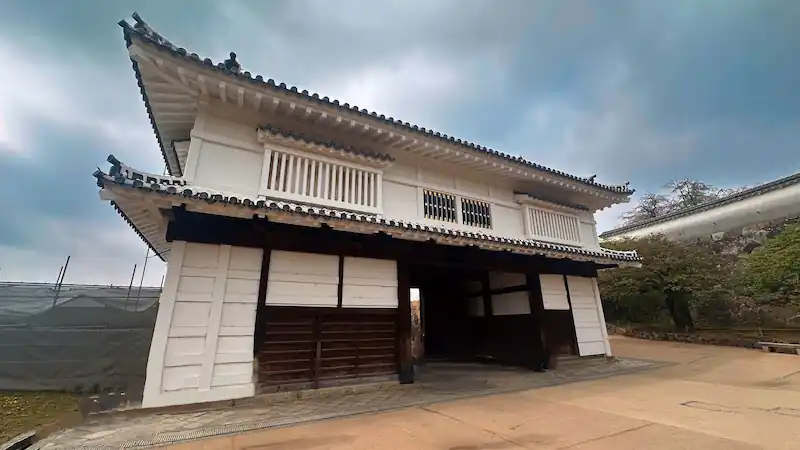
⭐ Recommended Rating
Historical Significance: ☆☆☆
Visual Appeal: ☆☆☆
Experiential Value: ☆☆☆
🏛 Overview
The Hishi-no-Mon Gate is the largest remaining gate in Himeji Castle and served as the formal entrance from the San-no-Maru to the Ni-no-Maru. This commanding tower gate exemplifies feudal prestige and power, especially with its namesake diamond-shaped metal ornament on the gable—a design reflecting samurai aesthetics and authority.
Built in a two-story kirizuma-zukuri style with tiled roofing, the gate’s heavy wooden doors are reinforced with iron fittings. It is flanked by a masugata (box-shaped defensive courtyard), designed to slow invaders and allow defenders to trap and attack them from multiple angles. This structure combined psychological intimidation with practical defense.
Constructed during Ikeda Terumasa’s massive renovation of Himeji Castle between 1601 and 1609, Hishi-no-Mon is a rare surviving structure from that period and is designated as an Important Cultural Property of Japan. Historically, only elite figures such as the daimyo and the shogun were permitted to pass through this gate—making it a “gateway of the chosen.”
Today, it is open to all, but standing beneath it still evokes the grandeur, formality, and architectural sophistication of feudal Japan. It is considered one of the highlights of the Himeji Castle experience.
| Item | Content |
|---|---|
| Year Built | Early 17th century (Edo period) |
| Builder | Ikeda Terumasa |
| Structure/Features | The largest gate at Himeji Castle, featuring a yaguramon design—a gate with a turret on top. Named “Hishi” (diamond) due to diamond-shaped crests on its pillars. |
| Renovation/Restoration | Restored during major renovations between 2010 and 2015. |
| Current Status | Still standing and serves as the main entrance to the inner castle grounds. |
| Destruction/Damage | Survived natural disasters and wartime bombings without significant damage. |
| Cultural Property Designation | Designated as an Important Cultural Property of Japan. |
🗺 Address:
68 Honmachi, Himeji City, Hyogo Prefecture (Himeji Castle, Ni-no-Maru entrance)
🚶 Access
Approx. 2-minute walk (150 m) from Onnazaka (Women’s Slope)
⏳ Suggested Visit Duration
Quick stop: 5 minutes
In-depth visit: 15 minutes (for examining structure, stonework, and ornamentation)
📍 Highlights
🔹 Largest Remaining Tower Gate: With thick timbers and white plaster walls, the gate is a fortress in itself, complete with arrow slits and drop holes.
🔹 Diamond Crest Ornaments: The distinctive hishi motifs are rare in castle design and add both aesthetic and symbolic gravitas. A popular photo spot.
🔹 Seasonal Beauty: In spring, cherry blossoms bloom around the gate, contrasting beautifully with its white walls. In autumn, vibrant foliage frames the structure and reveals views of the keep beyond.
📌 Trivia
Unexpected History: Hishi-no-Mon was reportedly rebuilt after a fire in the Edo period. The current gate retains the architectural style of the mid-Edo era.
Lesser-Known Fact: A ishi-otoshi (stone-drop trap) is still intact on the right side of the gate—highlighting its defensive ingenuity.
Famous Connections: During the Showa-era restoration, Crown Prince (now Emperor Emeritus) visited the gate, emphasizing its national heritage value.




comment